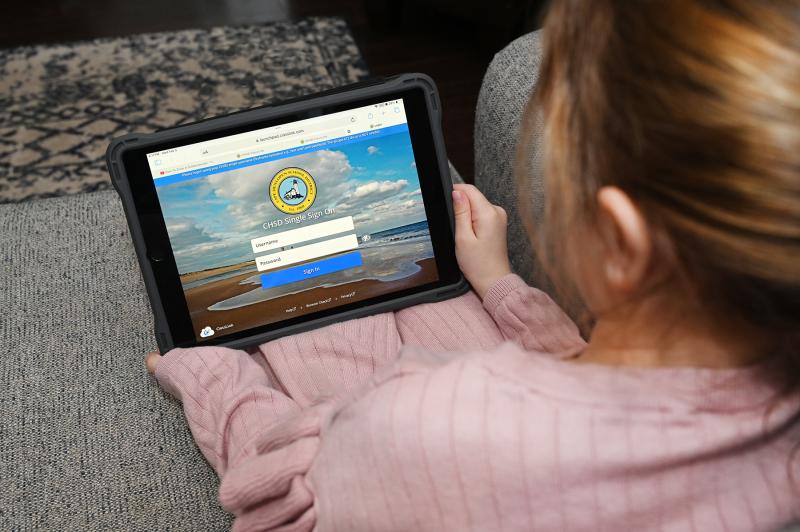If Punxsutawney Phil is correct, Cape Region students may have a few more snow days this winter.
But just because school is closed, it doesn’t mean students aren’t expected to learn. Following winter break in early January, Cape students were met with a snow day followed by four remote learning days.
While the overwhelming majority of feedback from families and teachers was positive, Director of Teaching and Learning LouAnn Hudson said some families were hit particularly hard.
“When I see that black graphic with white letters that says ‘CLOSED,’ my hope floats further away,” Arin Kluchnik wrote on Facebook in response to the district’s Jan. 10 post announcing its fourth consecutive asynchronous day. “I’m feeling isolated and under-resourced with all of these snow days.”
Kluchnik has a son with high-functioning autism in first grade at Lewes Elementary and a daughter with ADHD in preschool at Little Vikings at Sussex Consortium. While she stands with the district’s decision to keep the students home and prioritize their safety, she said it’s a very nuanced and complicated area of discussion.
“As a parent or caregiver, when you’re cooped up [and] you have kids with sensory issues who don’t want to put on snowsuits or mittens, and the American Academy of Pediatrics is saying you should limit screen time for their well-being … you’re using up your psychological resources trying to connect and entertain and educate your young children, your special needs children,” Kluchnik said.
Asynchronous and synchronous learning days, which were introduced during the COVID-19 pandemic, have become a way for schools to provide education remotely when weather conditions make it unsafe for students to attend in person. Unlike snow days, asynchronous and synchronous days count as normal school days and are not tacked on to the end of the school year. During asynchronous days, teachers provide students with school work to do at their leisure. For synchronous days, teachers remotely interact directly with students throughout the day.
The volume of the January snowstorm was a bit of an anomaly in Sussex County, where there was only one snow day last year and none the year before. According to Hudson, the district-wide procedure is to always make the first day a regular snow day, meaning no school or assignments for students. On subsequent days, the district will let families know whether there will be in-person instruction, another snow day, or an asynchronous or synchronous learning day.
While asynchronous learning certainly isn’t the preferred mode of teaching and learning, Hudson said, it can provide at least some sense of structure, which is important for students of all ages, especially younger kids and those with special needs. It seemed to be the best option in the midst of last month’s snowstorm.
“When you’re out of school for that long, we know it’s really important to try to offer [students] some normalcy from school, and to make sure that they are still connected to their teachers and getting ready for [their] return,” Hudson said. “It’s important to have that connection more than anything.”
The district talked with the teachers’ union before the start of the school year about potentially implementing asynchronous learning.
“Before we decide that that’s what we’re doing, we have our teachers [and] people on board saying, ‘Yes, this is the right thing for our kids and our teachers; let’s keep learning,’” Hudson said.
The district provides every student with an iPad and every teacher with a laptop, and they’re responsible for bringing their respective devices to and from school every day. This one-to-one policy allows schools to implement remote learning if necessary.
The district IT department’s systems showed that about 95% of students had their iPads during the winter break and recent snow event, and for those who didn’t, there were other ways for them and their parents to access their assignments.
Salena Quillen, whose daughter Lilah is in second grade at Milton Elementary, said she thinks the asynchronous days were a good alternative to just closing the school and not having the kids do anything for a week.
Lilah started school after the worst of the COVID-19 pandemic had passed, so last month was the first time she encountered any kind of at-home online learning. While the additional time away from school made it a little more difficult to get back into the swing of things, Quillen said, it was nice to have a little more time off.
She was able to work from home that week, so childcare was luckily not a concern.
“Some people who [were] not as fortunate as us with work probably depended on having their kids in school if they had to go to work, so I can understand the frustration,” she said. “But I agree with the school’s decision to close down all week, just because the roads were horrible, and I would not want the buses out.”
While an asynchronous learning day provides a little more structure than a regular snow day, it’s still not always enough for children, especially those with special needs.
Kluchnik said her children thrive with the routine and structure of school, and when they’re stuck at home, they lose much of that.
“When they don’t know what’s expected of them or what’s happening today, they get more anxious, and they push the boundaries because they’re looking for them,” she said. “I don’t have the bandwidth to put up the guardrails and all of the routine structure that a school has, because I’m not a teacher, I’m not a paraeducator, I’m not a disciplinarian, I’m not a lunch lady, I’m not the school nurse, I’m not a custodian. But when we’re doing asynchronous school, I have to fill all of those roles … and I get burnt out.”
She acknowledged that the school district can’t solve all of these problems, but thinks it would help if they encouraged parents and caregivers to support each other. She suggested the district make a short video to post on Facebook to encourage families to find creative ways to connect with each other while keeping safety in mind.
“You don’t have to be on an island in your home,” she said. “Check on each other. Talk to each other. Put your differences aside like they do when they’re at school and say, ‘Hey, can we get together to have the kids do a play group and then maybe we could read the assigned asynchronous reading lesson together?’ … There’s just more domestic turmoil when you don’t have enough outside help.”
For the most part, the feedback from teachers and families about the district’s decision to go asynchronous was generally positive, and most students logged in and completed their work, Hudson said.
Some parents, like Amber Erst, were initially confused by the district’s decision.
“What we saw were normal roads,” said Erst, whose daughter is a sophomore at Cape. “But to see other people’s stories and to understand that there were neighborhoods still completely covered in ice was crazy. I think that the safety of all of our children, not just our tunnel vision of our own children, is really important.”
Hudson said the district tries to make decisions that will benefit the greatest number of people – students, families, teachers, faculty members – possible, but no decision comes with a 100% approval rating.
Quillen added: “One parent’s emergency, or one parent’s [idea of] unsafe should be valued, but we can’t just do a mass thing because of one student. I think they’re going to do trial and error for a while here and figure out what works best for the community.”
“It was a slow start getting back,” Hudson said. “Getting everybody back in that routine is probably the hardest part. But it always feels good to get back into a regular routine, and we heard a lot of that from parents, from teachers, from everyone.”
Ellen McIntyre is a reporter covering education and all things Dewey Beach. She graduated with a bachelor’s degree in journalism from Penn State - Schreyer Honors College in May 2024, then completed an internship writing for the Pittsburgh Post-Gazette. In 2023, she covered the Women’s World Cup in New Zealand as a freelancer for the Associated Press and saw her work published by outlets including The Washington Post and Fox Sports. Her variety of reporting experience covers crime and courts, investigations, politics and the arts. As a Hockessin, Delaware native, Ellen is happy to be back in her home state, though she enjoys traveling and learning about new cultures. She also loves live music, reading, hiking and spending time in nature.

























































